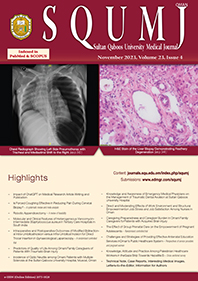Main Article Content
Abstract
Objectives: This study aimed to explore the quality of life (QoL) of Omani family caregivers (FCs) of patients with traumatic brain injury (TBI). After acute care, the burden of caring for patients with TBI is mainly shouldered by FCs. Methods: This cross-sectional study was conducted at Khoula Hospital, Muscat, Oman. Patient data were collected at the time of discharge and 8 weeks post-discharge between April 2019 and December 2021. The SF-12 General Health Survey and Preparedness for Caregiving scale were used to measure the caregivers’ QoL and preparedness, respectively. The Disability Rating and TBI Symptom scales were used to measure the patients’ disability and symptoms, respectively. Results: A total of 36 FCs and patients with TBI were recruited. Most caregivers were the parent (41.7%) or child (27.8%) of the patient with TBI. Overall, the caregivers had good physical QoL (PQoL) and mental health QoL (MHQoL) but low caregiving preparedness at the time of discharge. At 8 weeks post-discharge, there were significant improvements in caregiving preparedness (P <0.01) and patient disability (P <0.05) but a depreciation in caregivers’ MHQoL (P <0.05), with no change in their PQoL. The caregiver’s employment status and the severity of the patient’s sleep and mood problems were modifiable predictors of the caregivers’ PQoL. Caregiver’s preparedness, the patient’s inability to live independently, and the severity of the patient’s mood and behavioural problems were predictors of caregivers’ MHQoL. Conclusion: Caring for patients with TBI negatively impacts the QoL of Omani FCs; this correlates with the physical, emotional, and mental health symptoms of the patient.
Keywords: Family; Quality of Life; Caregiver Burden; Caregivers; Traumatic Brain Injury; Oman.
Article Details

This work is licensed under a Creative Commons Attribution-NoDerivatives 4.0 International License.
